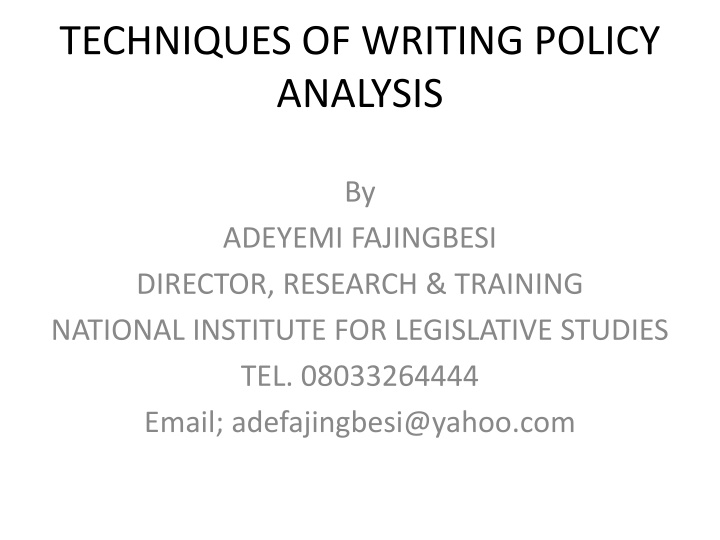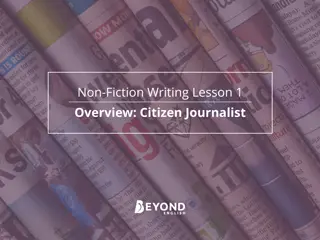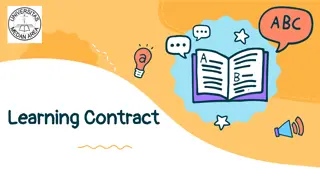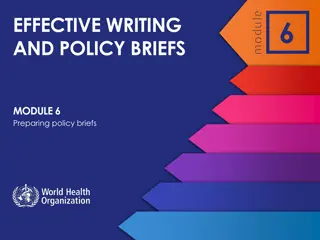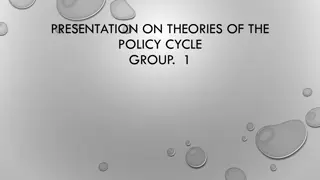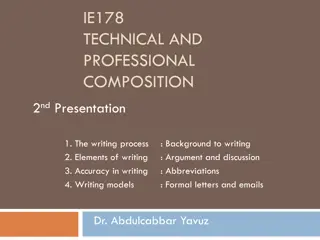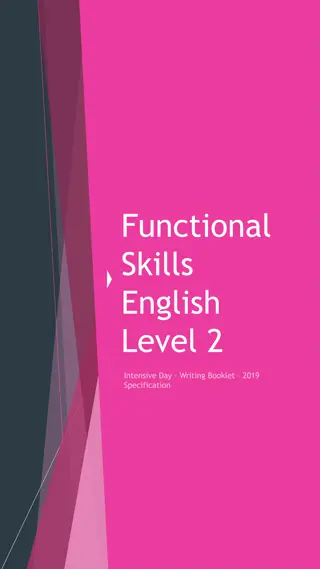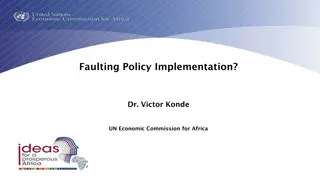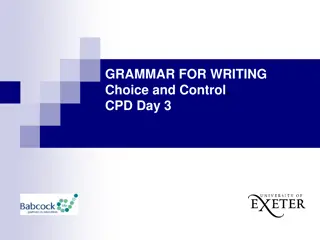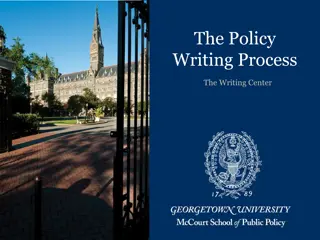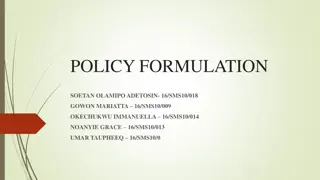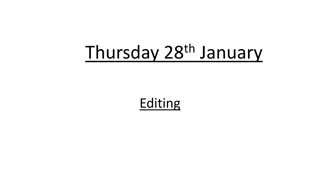Techniques of Writing Policy Analysis by Adeyemi Fajingbesi
Adeyemi Fajingbesi presents a comprehensive guide on policy analysis highlighting the nature of public problems, the importance of policy recommendations, and a step-by-step approach to conducting sound policy analysis. Learn about defining problems, setting goals, selecting and implementing policies, and evaluating their effectiveness.
Download Presentation

Please find below an Image/Link to download the presentation.
The content on the website is provided AS IS for your information and personal use only. It may not be sold, licensed, or shared on other websites without obtaining consent from the author.If you encounter any issues during the download, it is possible that the publisher has removed the file from their server.
You are allowed to download the files provided on this website for personal or commercial use, subject to the condition that they are used lawfully. All files are the property of their respective owners.
The content on the website is provided AS IS for your information and personal use only. It may not be sold, licensed, or shared on other websites without obtaining consent from the author.
E N D
Presentation Transcript
TECHNIQUES OF WRITING POLICY ANALYSIS By ADEYEMI FAJINGBESI DIRECTOR, RESEARCH & TRAINING NATIONAL INSTITUTE FOR LEGISLATIVE STUDIES TEL. 08033264444 Email; adefajingbesi@yahoo.com
Objectives After this presentation, you should understand policy analysis appreciate the relevance of policy analysis know the critical elements to conduct sound policy analysis (and design / implement sound policies)
Introduction to Policy Analysis The nature of public problems is such that : they are often ill-defined they have political as well as purely technical aspects they often lack a good cause-effect knowledge base they may be solved but in so doing new problems emerge their solution often involves trade-offs between cost and effectiveness it may be hard to measure adequacy of results it may be hard to measure fairness of results
What is Policy Analysis? Policy recommendations, or simply written policy advice, are the key means through which policy decisions are made in most levels of government. Whether the policy recommendation is accepted as sound or dismissed in favor of another option largely depends on how well the issue and the arguments justifying the recommended course of action are presented. POLICY ANALYSIS defines the problem and the goals, examines the arguments, and analyzes implementation of the policy
What is Policy Analysis? A before hand attempt to examine, measure and evaluate the impact/effect of policy It seeks to answer 6 questions: (1)What is the actual policy being formulated? (2)How is the policy determined? (3)Why is policy X chosen not Y? (4) Is the policy selected the best? (5) Why has the policy succeeded or failed? (6) How can the policy be improved?
What is Policy Analysis? Policy Analysis is practical flexible, situational addresses local problems focus on decision-making Craft
A step-by-step guide Step 1: Defining the problem Step 2: Establishing goals Step 3: Selecting a policy Step 4: Implementing a policy Step 5: Evaluating the policy
Step 1: Defining the problem What is the problem to be addressed? What was the event or series of events that was a catalyst for action? Is it a problem or crisis that demands immediate attention? Is the problem one of national security, economic development, diplomacy? What interests are at stake for the actor (e.g. state) overall?
Step 2: Establishing goals How will you translate the aforementioned problem into a specific set of goals? What is the relationship between those goals and the problem that was identified? What government or non-government organizations are involved in making this decision? Which ones are not involved? Are there other interests (e.g.in the region) that should be considered in your analysis?
Step 3: Selecting a policy Based on your research and understanding of the situation, select a policy, and consider the following: What other alternatives were considered? Why were the other alternatives rejected? For rational or political reasons? Describe the tradeoffs policy makers must accept based on your selection what tradeoffs do policy makers see as inherent in the selected policy
Step 4: Implementing a Policy What agency or organization implemented the policy? Was the policy implemented according to original design? Has the agency changed or skewed the policy to reflect its own interests and goals? Which changes were made from the original design and why are they important? In your opinion, could another agency have implemented the policy better?
Step 5: Evaluating the Policy Did the policy achieve its goals? Did the policy solve the original problem? Or did the policy solve a different problem that the one originally identified? What were the costs and consequences of the policy? Did the policy achieve its goals at a reasonable cost? Overall, was the policy a success or a failure ?
Quality of a well-written policy analysis Make it Readable: No matter how complex the issue, or the recommendation, your ideas must be clear and readable. Read the policy analysis out loud to yourself or have a room mate test its readability. Be accurate: Policy recommendations must be based on the most recent, accurate and complete information available. Visit the Library to obtain the most recent publications available and also use the internet to your advantage current affairs peer reviewed publications are released frequently through think tank web sites and academic data bases. Be Concise: Decision- makers are busy people. Keep your documents as focused and concise as possible so that your readers spend only the minimum time required to glean the information they need from them. Conciseness is really a product of the revising and editing stages.
